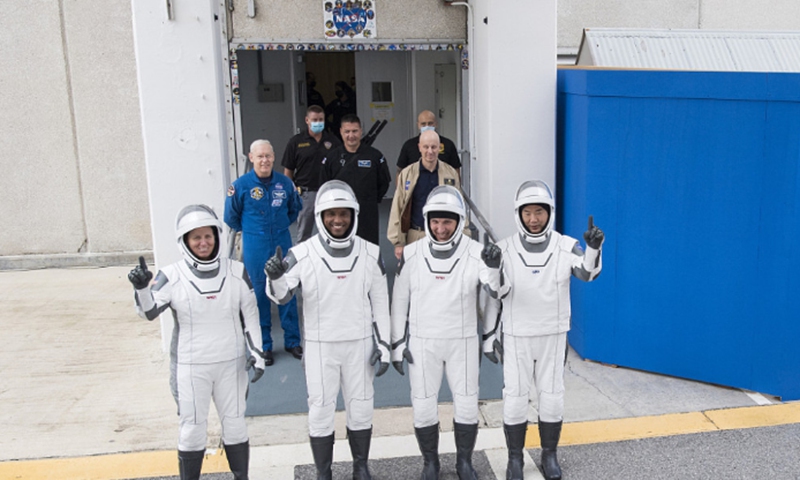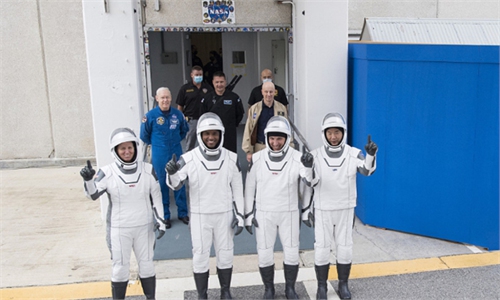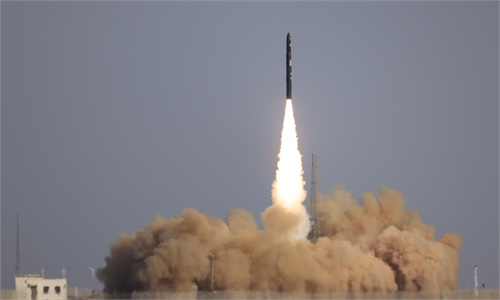SOURCE / INDUSTRIES
SpaceX’s historic human spacecraft launch a milestone success

NASA astronauts Shannon Walker, left, Victor Glover, second from left, Mike Hopkins, second from right, and Japan Aerospace Exploration Agency (JAXA) astronaut Soichi Noguchi, right, wearing SpaceX spacesuits, stop to pose for a picture as walk out of the Neil A. Armstrong Operations and Checkout Building to depart for Launch Complex 39A during a dress rehearsal prior to the Crew-1 mission launch, on Nov. 12, 2020, at NASA's Kennedy Space Center in Florida. Photo: VCG
Elon Musk's space venture SpaceX sent four astronauts to space on the first NASA-certified commercial spacecraft on Sunday, a milestone achievement that remains beyond the reach of Chinese private-sector space firms, which have been striving to accelerate the nation's space commercialization, industry watchers said.
SpaceX's Crew-1 mission with four people on board successfully lifted off in Florida, a historic step toward basing manned spaceflight on a government-private partnership, in which a SpaceX Falcon 9 rocket carrying the venture's Dragon capsule was sent into orbit to start a six-month mission aboard the International Space Station.
It's still a long way off for Chinese private-sector space ventures to catch up with SpaceX, Huang Zhicheng, a veteran expert on space technology, told the Global Times on Monday.
SpaceX is known for its prowess in liquid-fueled rockets capable of delivering heavy payloads, while private-sector ventures in China are still focused on light-lift solid rocket projects, Huang said, describing human spaceflight commercialization as a much longer-range objective for China.
Private space firm Galactic Energy successfully sent a satellite into orbit over the weekend, the fourth private-sector launch enterprise in China to make an orbital launch attempt.
The first such successful attempt was made in July 2019 by private-sector rocket firm iSpace. The initial two launches in October 2018 and March 2019 failed.
Yao Bowen, a vice president of iSpace, told the Global Times on Monday that it is important for Chinese commercial space players at the moment to keep their feet on the ground, even if "their heads are in the clouds" as they pursue their products and technologies.
Yao said the company is focused on developing scale launches according to real market demand.
The reusable liquid-oxygen methane engine, independently developed by iSpace, has the ability to carry out secondary-stage ignition and large-scale continuous variable thrusting. These features are the keys to recovery and reuse of the launch vehicle.
The first liquid-fueled launch attempt by a private firm in China could happen in two to three years, Huang predicted.
In an interview with the Global Times at the end of 2018, Yang Yiqiang, the first commander-in-chief of the Long March 11 solid-fuel carrier rocket project, said that industry watchers were not bullish on SpaceX before 2010.
"The situation has changed, thanks to talent mobility. NASA's space shuttle program came to an end with the Atlantis' Space Shuttle launch in 2011, and SpaceX succeeded in garnering talent," Yang said, adding that the US aerospace manufacturer's rise to prominence can also be attributed to shared intellectual property enabled through a set of regulations.
In China's case, the so-called national team including China Aerospace Science and Technology Corp - the main contractor for China's space program - is a collection of companies shouldering social responsibilities as well as striving to prove themselves commercially viable, Yang said, calling for the creation of "a mechanism to protect the national team's interests while ensuring its intellectual property is converted to social benefits."
Huang said that the national team is technologically and financially competent in mounting human flights, but the involvement of private partners in human missions won't be easy, which will require a mixed-ownership reform of the state-owned champions.


